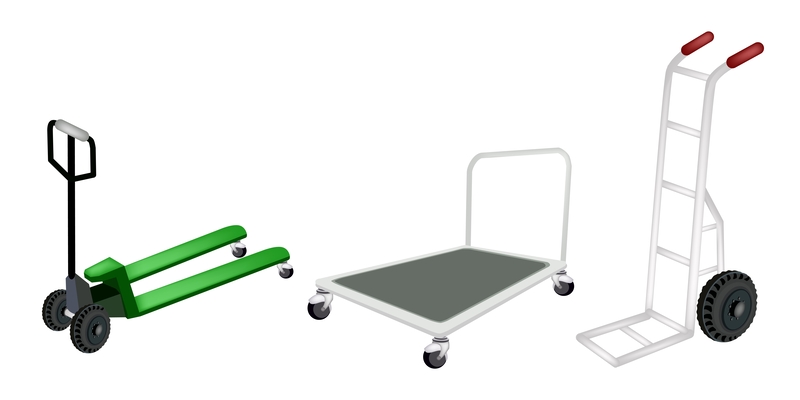Become a Pro at Storing Freezers During Downtime
Posted on 17/05/2025
Become a Pro at Storing Freezers During Downtime: The Ultimate Guide
Are you grappling with the question of how to store your freezer when it's not in use? Whether your freezer is commercial, industrial, or residential, proper freezer storage during downtime is essential for ensuring longevity and optimal performance. Smart storage not only prevents unexpected maintenance headaches but also preserves the quality of your investment. In this comprehensive guide, discover how you can become a pro at storing freezers during downtime with simple yet effective strategies.

Why Proper Freezer Storage Matters
Many overlook the importance of correct freezer storage when their appliance is not working or awaiting its next active phase. Whether it's a seasonal lull in a business or a temporary halt in household use, freezer downtime can lead to issues such as mold buildup, unpleasant odors, and even irreparable mechanical damage. Implementing best practices now can save you from costly repairs and replacements later.
- Prolonged Appliance Life: Proper care during inactivity reduces wear and tear.
- Hygiene and Safety: Stops mold, mildew, and pests from taking over unused compartments.
- Energy Efficiency: Ensures efficient operation on restart.
- Lower Maintenance Costs: Prevents expensive repairs due to neglected storage protocols.
Prepare Your Freezer for Downtime
1. Power Down the Right Way
Before storing, it's vital to turn off your freezer safely. Disconnect from the power source and unplug the unit. This prevents any electrical damage and ensures your safety during cleaning and storage.
- Unplug the Freezer: Don't just switch off--completely disconnect from electricity.
- Wait for Defrost: Allow at least 24 hours for the freezer to thaw any remaining ice.
- Follow Manufacturer Instructions: Always check your appliance manual for specific shutdown procedures.
2. Clear Out All Items
To excel at freezer downtime storage, remove all food, ice packs, trays, and removable shelves or bins. Throw out expired goods and transfer salvageable items to another freezer or consume them to minimize waste.
- Discard spoiled or perishable food items.
- Clean and dry removable components.
- Store shelves and bins separately if possible.
3. Deep Clean and Sanitize
A thorough cleaning is a crucial step to prevent lingering odors and bacterial growth. Use a mild detergent, warm water, and, for stubborn spots, a mixture of baking soda and water.
- Wipe interior walls and shelves with a soft cloth or sponge.
- Rinse with clean water and dry completely to prevent mold.
- Deodorize: Place an open box of baking soda inside before closing for storage.
4. Combat Moisture and Odors
Excess moisture and trapped air can do significant damage during freezer downtime. Moisture encourages bacterial growth, rust, and odor.
- Leave the freezer door open slightly to encourage air circulation.
- Use a towel or wedge to prop the door open if necessary.
- Consider placing a moisture absorber, such as silica gel packs, inside.
Ideal Locations and Conditions for Freezer Storage
The environment you pick for holding your freezer during inactivity is as important as your preparation steps. The right storage location can make all the difference:
- Temperature Stability: Avoid extreme cold or heat. Garages, basements, and climate-controlled rooms are ideal.
- Protection from the Elements: Never store outdoors or in direct sunlight. Moisture, rain, and condensation are major enemies.
- Flat and Even Surface: Set your freezer on a stable, level floor. This protects both the unit's door seal and the compressor.
- Away from Chemicals: Store away from gasoline, paint, or cleaning agents, which can corrode parts or create dangerous fumes.
Top Tips for Managing Extended Freezer Downtime
Guard Against Pests and Rodents
Unused freezers are tempting hides for rodents and insects. Safeguard your appliance with these easy measures:
- Seal up all vents and holes using mesh or steel wool.
- Check surrounding areas for crumbs or attractants.
- Position the freezer away from walls to limit access points.
Protect Electrical Components
- Wrap the power cord securely and fasten it to the back of the freezer to prevent tripping or fraying.
- If storing long-term, cover external coils and controls with plastic sheeting for dust protection.
Keep the Door Gaskets Healthy
Door seals (gaskets) are prone to drying out and cracking. Treat them with a small amount of petroleum jelly to retain flexibility and ensure a tight seal when you reactivate the freezer.
Seasonal Storage vs. Long-Term Downtime
Not all downtimes are created equal. The best practices for storing freezers during downtime depend on whether your appliance will be resting for weeks or many months:
Short-Term Storage (Under One Month)
- Follow the basic cleaning and prepping steps above.
- Check periodically for moisture or odors.
- Avoid placing items on top that could damage the lid or hinge.
Long-Term Storage (Over One Month)
- Deep clean and prop doors open for maximum air circulation.
- Inspect the area regularly for leaks, pests, or rust.
- Consider a light dust cover--but never an airtight wrap, which may trap moisture.
Reactivating Your Freezer After Downtime
When you're ready to put your freezer back into service, follow these reactivation tips to ensure safe and efficient operation:
- Remove any moisture absorbers or deodorizing agents from the interior.
- Inspect the power cord, plug, and seals. Replace if you notice damage or excessive wear.
- Plug in and run the freezer empty for several hours to reach optimal temperature before restocking.
- Listen for unusual noises that may indicate a mechanical issue.
- Clean shelves and bins again before reassembling and filling.
Top FAQs on Storing Freezers During Downtime
Q: Can I leave my freezer unplugged for several months?
A: Yes, but only if you have cleaned, dried, and propped open the door to prevent mold and odor. Store in a stable environment with good ventilation for best results.
Q: Should I cover my freezer during storage?
A: A loose, breathable dust cover is recommended, but never use an airtight plastic wrap that could trap moisture and encourage mildew.
Q: Is it okay to store a freezer in a cold garage?
A: Temperature extremes, especially freezing, can damage the compressor and seals. Ideally, choose a climate-controlled space or insulate the area around the freezer to prevent damage during colder months.
Q: What should be placed inside a dormant freezer to prevent odors?
A: An open box of baking soda, activated charcoal, or even crumpled newspaper can help absorb unpleasant odors.
Q: How often should I check a stored freezer?
A: It's a good idea to inspect your freezing unit every few weeks during downtime, looking for condensation, pest activity, or rust formation.
Common Storing Mistakes to Avoid
- Leaving Food Behind: Even sealed, old food can attract pests and breed bacteria.
- Sealing the Door Tightly: This traps moisture and accelerates mold/mildew.
- Storing Outdoors: Exposure to the elements can warp or destroy freezer components.
- Ignoring the Power Cord: Coiled power cords left on the floor are a tripping hazard and can degrade faster.
- Failing to Check Regularly: Problems left unnoticed can worsen considerably over time.

Commercial and Industrial Freezer Storage: Special Considerations
While home freezers benefit from these tips, commercial and industrial units require added attention. Consider these extra steps for large-scale freezer downtime storage:
- Professional Servicing: Have a technician perform a maintenance check before and after downtime.
- Drain Lines: Ensure all water and coolant lines are fully drained to prevent freezing or bacterial growth.
- Compressor Care: Consult the manufacturer about special procedures for storing your specific model.
- Documentation: Keep a record of maintenance and reactivation steps for food safety audits.
Final Thoughts: Unlock the Secrets to Expert Freezer Storage
Becoming adept at storing freezers during downtime isn't just about following a checklist--it's about protecting your investment for the long haul. From power-down to reactivation, each step ensures your freezer runs efficiently and safely when you need it most. Observe best practices for downtime management, stay vigilant with routine checks, and your freezer will reward you with years of loyal service.
Ready to become a pro at freezer storage? Implement these strategies today and enjoy peace of mind, knowing your appliance is in prime condition--no matter how long its downtime lasts!







